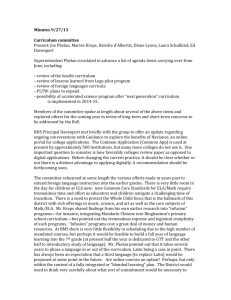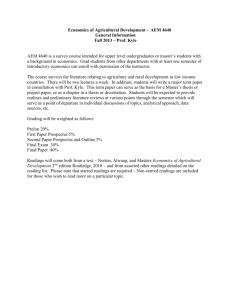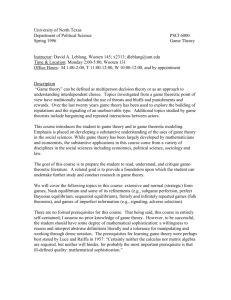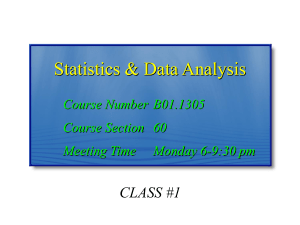MBAO 6030 HUMAN RESOURCES MANAGEMENT
advertisement
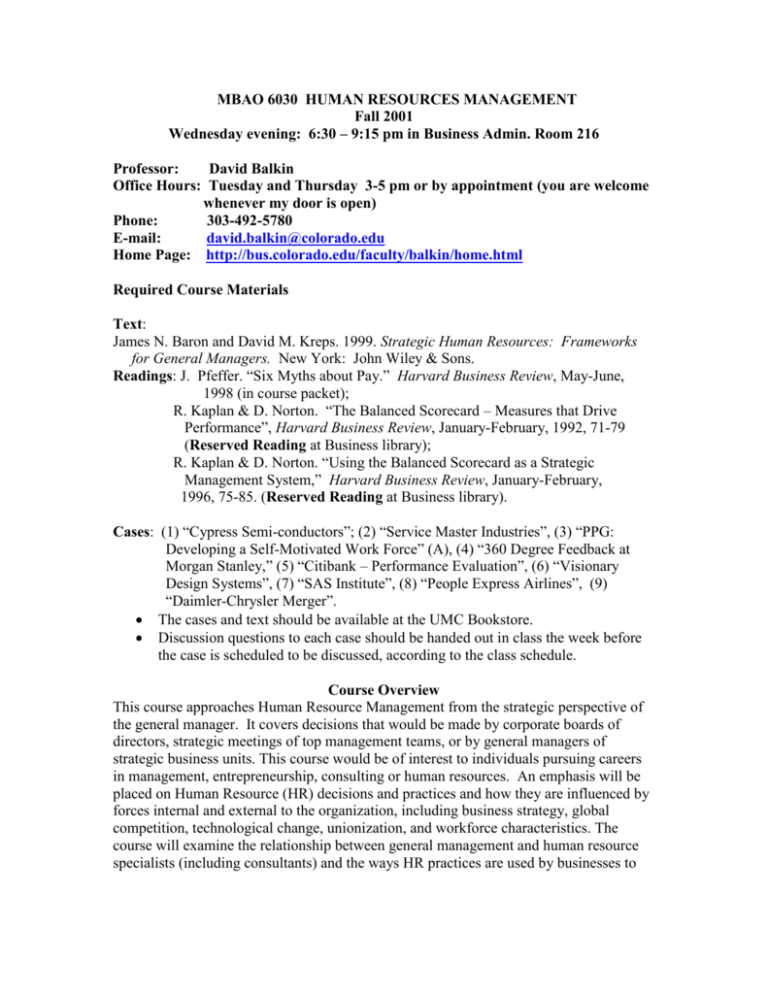
MBAO 6030 HUMAN RESOURCES MANAGEMENT Fall 2001 Wednesday evening: 6:30 – 9:15 pm in Business Admin. Room 216 Professor: David Balkin Office Hours: Tuesday and Thursday 3-5 pm or by appointment (you are welcome whenever my door is open) Phone: 303-492-5780 E-mail: david.balkin@colorado.edu Home Page: http://bus.colorado.edu/faculty/balkin/home.html Required Course Materials Text: James N. Baron and David M. Kreps. 1999. Strategic Human Resources: Frameworks for General Managers. New York: John Wiley & Sons. Readings: J. Pfeffer. “Six Myths about Pay.” Harvard Business Review, May-June, 1998 (in course packet); R. Kaplan & D. Norton. “The Balanced Scorecard – Measures that Drive Performance”, Harvard Business Review, January-February, 1992, 71-79 (Reserved Reading at Business library); R. Kaplan & D. Norton. “Using the Balanced Scorecard as a Strategic Management System,” Harvard Business Review, January-February, 1996, 75-85. (Reserved Reading at Business library). Cases: (1) “Cypress Semi-conductors”; (2) “Service Master Industries”, (3) “PPG: Developing a Self-Motivated Work Force” (A), (4) “360 Degree Feedback at Morgan Stanley,” (5) “Citibank – Performance Evaluation”, (6) “Visionary Design Systems”, (7) “SAS Institute”, (8) “People Express Airlines”, (9) “Daimler-Chrysler Merger”. The cases and text should be available at the UMC Bookstore. Discussion questions to each case should be handed out in class the week before the case is scheduled to be discussed, according to the class schedule. Course Overview This course approaches Human Resource Management from the strategic perspective of the general manager. It covers decisions that would be made by corporate boards of directors, strategic meetings of top management teams, or by general managers of strategic business units. This course would be of interest to individuals pursuing careers in management, entrepreneurship, consulting or human resources. An emphasis will be placed on Human Resource (HR) decisions and practices and how they are influenced by forces internal and external to the organization, including business strategy, global competition, technological change, unionization, and workforce characteristics. The course will examine the relationship between general management and human resource specialists (including consultants) and the ways HR practices are used by businesses to build and maintain competitive advantage. Some of the decision content areas examined in this course include the following: Human Resource Management Strategies Investments in Human Capital High Performance Work Systems Performance Management Policies and Tools Management Incentive Systems Human Resource Impacts of Mergers and Acquisitions Integrating HR and Business Strategies Conduct of the Course The methodologies used in the course include short lectures, class discussions of assigned readings with critical thinking questions, case discussion sessions (some will be led by the instructor and others led by student teams), and guest speakers. A written research paper on a topic related to the course content and of interest to each student will be presented during one of the last few course sessions. Preparation of assigned readings and completion of other assignments prior to class and active participation in the class are vitally important for the accomplishment of our learning objectives. Each class member should read assigned materials and come prepared to actively participate in all class discussions. You can contact me by phone or e-mail if you have any questions about the course assignments. Here is some additional information. Please turn off your cell phone so it does not disrupt the class. A short break will be given in the middle of the 3-hour class session. About the Instructor: David B. Balkin is a professor of management in the College of Business and Administration at the University of Colorado at Boulder. He received his Ph.D. at the University of Minnesota, and is considered an international authority on strategic compensation and human resource management. He has written over 45 articles in scholarly and practitioner journals on human resources and compensation topics as well as co-authored four books on compensation and human resources. He is co-author of Compensation, Organizational Strategy and Firm Performance (1992, South-Western), which is widely recognized as a seminal work on the subject of compensation. He is also co-author of Managing Human Resources (2001, 3rd edition, Prentice-Hall), a widely used text on human resources used in the US, Canada, Spain and much of Latin America. His latest book Management, a text on basic principles of management, will be published early in 2002 by Irwin McGraw-Hill. Professor Balkin has taught seminars on human resource topics to executives in the US, Canada, the Dominican Republic, Denmark, Norway, Spain, France and Israel. Course Requirements The grade for this course will consist of the following elements: Exam I 25 Percent Exam II 25 Percent Individual Project 25 Percent Team Analysis of Reading or Case 10 Percent Individual Class Participation 15 Percent TOTAL 100 Percent There will be two exams given during this course. The exams will be given on October 10 and on November 14. The exams will consist of several essay questions that will involve critical thinking about the content of the course. The exam will be a closed book exam. There will be multiple parts to each essay question. You will be given two hours to write your answers for the exam. The second exam will cover only the course content given since the first exam. Grading Policy Grades for graduate students in this elective course can range from B- to A with a mean grade around the B+ level. Sometimes a grade less than B- could be warranted when a graduate student's work falls below acceptable expectations. I will provide a second opinion on a grade only if there is a good reason to re-evaluate an exam or project. Team Analysis of Case or Assigned Readings Teams will be formed at the beginning of the semester and will be used to lead the class in a discussion of some of the assigned cases. The purpose of this assignment is to share ownership of the learning with graduate students so that they take responsibility for their own and others' learning rather than depend on the instructor to provide all the inputs. The teams will consist of about 3 or 4 people and they will be formed voluntarily. An ice- breaker exercise will be used to facilitate the team selection process. Each team will be asked during the course to lead the class on a discussion on a case during a specific class meeting. The assignment of the assigned cases to teams will be made early in the semester based on a lottery system. A list of the cases from the syllabus to be presented will be posted and teams will select their preference when their lottery number is selected. The basis of the team evaluation for this element of the course will be the quality of preparation of the team (did the team understand and master the content of the case and could they convey that understanding to the class?) and the quality of the class discussion that the team is able to produce (was the team able to generate an enthusiastic discussion of the case?). This means involving and engaging other class members in the case analysis, in the role of a facilitator, to influence their learning and understanding of the content. You may also want to use your team members as a study group (outside of class or via the Internet) to discuss each case and the assigned questions before the class meeting that examines the case. Individual Class Project The class project is designed to let you learn and develop some in-depth expertise on a specialized topic in human resource management and then teach the rest of the class about your topic during one of the last three class sessions of the semester. There will be two deliverable outcomes that will be expected from this project. First, a written report on the topic in human resource management is required. Your report audience should be professionals in business such as executives, managers, entrepreneurs and such. The length of the paper should be between 10 and 15 pages (double spaced) of text with tables and exhibits, and list of references being considered as additional pages to the text. The style of writing and presentation of the report should be similar to a practitioner business journal such as Academy of Management Executive, Human Resource Planning, Human Resource Management and WorldatWork Journal, all of which are located in the Business library. There should be a one page executive summary at the beginning of the paper. The basis for evaluating the written report will be quality of content (quality of research, meaningful content and timely information), clarity of expression (including well designed tables and charts) and organization (all the parts of the paper should fit together). Second, an oral presentation of your topic to the class of about 20 minutes duration to teach the class the fundamentals of your topic is required. A general guideline for managing your presentation time would be to take 20 minutes for your prepared comments and leave another 5 minutes to answer questions from the audience. The goal of the presentation is to educate the audience and interest them in your topic. The style of the presentation should be similar to what one would be expected to give at a professional conference or workshop. Some class time will be allocated for coordinating the projects later in the semester. The topic for your paper and presentation should fall within the domain of human resource management from the perspective of a general manager. This provides a wide latitude to select an interesting topic. The report could give you the opportunity to learn in greater depth about a topic that was covered perhaps superficially in the course content. Or, you could examine an interesting human resource policy or program at a company where you did your internship or have had some personal experience with. Another possible approach would be to choose a topic you would like to learn more about and share the findings with your colleagues. Here are a few examples: Employment Contracts for Executives Variable Pay systems at IBM Defined Contribution Health Plans – a new approach to managed health care The Use of Forced Distribution Performance Evaluations – Ford and GE’s experience On the fifth week of the semester (September 26) I will expect to receive a one-page abstract that briefly describes your topic. This will give me an opportunity to give you some feedback and make sure your topic fits with the goals and expectations of the course. Finally, please make sure you properly cite any references you employ in writing your paper. You can use footnotes (if necessary for direct quotes or citing a specific fact that is not well known) and a list of references at the end of the paper (only the references you actually use in the preparation of your paper should be listed in your reference list). Make sure your exhibits look professional and are properly labeled. If you have any questions, it is better to ask me or send me an email message. Class Participation Each member of the class will be expected to attend each class and participate in class discussions since this MBA class only meets one time per week. If you cannot attend a class I would expect you to notify me in advance via e-mail or voice mail that you will not be attending the class. I will permit each person to have one absence without having it influence the participation grade. An exception to this one absence policy may be possible only if there is a documented reason for it. For those with perfect attendance, I will throw out their lowest participation score and average the rest. Class participation will be judged on the quality not quantity of the contribution. During class I will ask for volunteers and also will feel free to cold call on individuals from time to time. Quality contributions represent putting your own interpretation on the facts of a case or the discussion topic so that it represents critical thinking. Examples of quality contributions may include building and expanding on the input of one of your peer’s comments, integrating content from an earlier class into the current class discussion so that some new connections are formed, challenging another student’s or the instructor’s comment with a different perspective that illuminates the topic, or by explaining a difficult concept to the rest of the class by doing some self-initiated research to better understand it. While I will keep track of participation each week, at the end of the semester I will ask myself about each class member with respect to participation this question: “what did this person contribute to the quality of the class learning experience during the semester?” What matters is the pattern of overall class participation that you establish during the semester. Feel free to stop by my office during the semester to receive my feedback on your participation so you can make adjustments if necessary. SCHEDULE OF COURSE TOPICS, READINGS AND CASES Week # 1: August 29 Course Expectations Guidelines for individual projects Ice Breaker exercise Week # 2: September 5 Strategic Role of Human Resources Text: Baron & Kreps, chapters 1, 2 and 3. Case: “Cypress Semiconductors” (A) Form Teams for assigned cases to be presented in class Week # 3: September 12 High Performance Work Systems Text: Baron & Kreps, chapters 4, 5, 6 and 9. Case: “PPG: Developing a Self-Motivated Work Force”. Week # 4: September 19 Investments in Human Capital Text: Baron & Kreps, chapters 15 and 16. Case: “Service Masters Industries”. Week # 5: September 26 Performance Management I - Design Text: Baron & Kreps, chapter 10 Case: “360 Degree Feedback at Morgan Stanley”. Individual Project Topic Abstract/Descriptions are Due Week # 6: October 3 Performance Management II – Implementation Readings: 2 articles on the Balanced Scorecard by Kaplan & Norton from the Harvard Business Review (1992 and 1996) – available as Reserved Readings in the Business Library. Case: “Citibank – Performance Evaluation.” Week # 7: October 10 EXAM 1 – covers content of weeks 2-6 SCHEDULE OF COURSE TOPICS, READINGS AND CASES Week # 8: October 17 Strategic Reward Systems I Text: Baron & Kreps, chapter 11 Reading: Pfeffer reading on “Six Myths about Pay” from Harvard Business Review (1998) in case packet. Case: “Visionary Design Systems.” Week # 9: October 24 Strategic Reward Systems II Text: Baron & Kreps, chapter 12 Case: “SAS Institute.” Week # 10: October 31 Impacts of Mergers, Acquisitions, Downsizing and Outsourcing on HR Practices Text: Baron & Kreps, chapters 17 and 18 Case: “Daimler-Chrysler Merger” Week # 11: November 7 Integrating HR Strategy with a Firm’s Business Strategy Text: Baron & Kreps, chapter 19 Case: “People Express.” Individual Project Presentation Dates Selected (one of last 3 weeks) Week # 12: November 14 EXAM 2 – covers content of weeks 8-11 Week # 13: November 21 – No Class in lieu of Fall Break Week # 14: November 28 Special HR Topics Guest Speaker: HR Executive to be announced Presentations of Individual Projects Week # 15: December 5 Special HR Topics Presentations of Individual Projects Week # 16: December 12 Special HR Topics Presentations of Individual Projects


